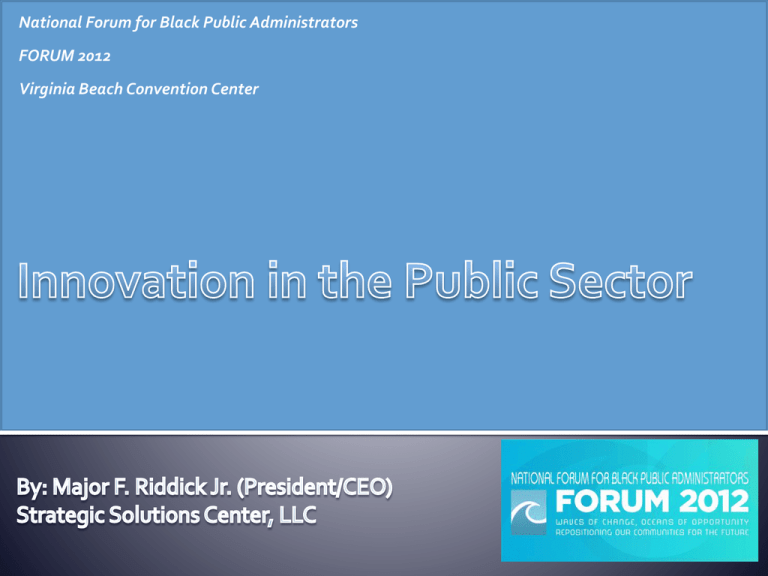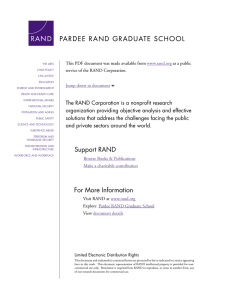Innovation in the Public Sector
advertisement

National Forum for Black Public Administrators FORUM 2012 Virginia Beach Convention Center ▪ Public service is typically perceived as compliance oriented and rule bound rather than innovative and creative ▪ New ideas are often resisted because they undermine existing power relations, threaten entrenched interests or challenge the deeply ingrained views of others Building an innovation culture in a public sector organization requires leadership and addressing these problems as opportunities The innovation process starts with creating an environment that allows for ideas and innovation to be effectively evaluated and eventually integrated. Innovation is an integrated process that evolves in three main phases (Creativity Phase, Development Phases, and Diffusion Phase). Each phase has its own deliverable. Before proceeding to the next phase this deliverable is evaluated against its criteria. Innovation normally flows from one phase to the next in a linear fashion. Sometimes, different elements of the innovation process might be executed concurrently or a cue might be jumped. It is important to maintain flexibility Creativity Phase Development Phase Diffusion Phase Increasing creativity outputs through a deliberate search for opportunities. The most common technique in this regard is through a frequent interaction with stakeholders and customers The networking with other entities, public organizations, non-profit organizations as well as businesses is another great way for a public service organization to learn and seek innovation opportunities To effectively maneuver through the development phase you must utilize a team approach that provides for a systemic, disciplined approach to risk management, project evaluation and decision making. The development of ideas is not a random process and should not be left to chance. This is essentially the “roll out” phase but in this step the innovator needs to consider being flexible for changes on how to deploy the new innovation. In successful organizations, an innovation diffusion execution plan is done up-front even before any development work begins. A good innovation diffusion plan is flexible and accounts for an ever-changing world and evolving social and personal needs and preferences The established innovation framework (Figure B) is an integrative and guiding framework that can enable public service organizations to be consistent in their innovation. It identifies the most important success drivers that influence the innovation process from conceptual ideas to diffusion. The framework contains six major focus areas: business strategy linked to innovation strategy performance metrics knowledge management risk management project management change management The top factors in the framework are more strategically orientated compared to the bottom factors that are most likely applied at the tactical (operational) level. There is no single, standalone driver of the innovation success. All the drivers need to be present and act in the same direction in order for innovation to be consistently successful. The three tasks of leadership can be described as setting direction, creating alignment, and building commitment. When direction, alignment and commitment are created around innovation, organizations emerge as more productive and more innovative. Leadership for organizational innovation requires: Organizational Encouragement Lack of Organizational Impediments Leadership Encouragement Sufficient Resources Realistic Workload Freedom Challenging Work Teamwork and Collaboration Major F. Riddick Jr. President/ CEO Strategic Solutions Center, LLC 8181 Professional Place Suite 202 Landover, MD 20785 mriddick@strategicsolutionscenter.com








